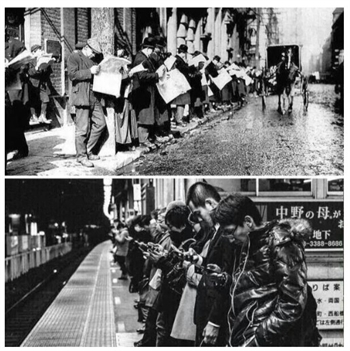
Metropolitan Planning Council
Professor Hampton spoke at the event about technology's effect on public interaction.
 By Hui Feng and MPC Research Assistant Kevin Symcox
By Hui Feng and MPC Research Assistant Kevin Symcox - December 5, 2014
People have always feared technological change. Keith Hampton, a Rutgers University professor and the Metropolitan Planning Council’s (MPC) guest speaker on Thursday, Nov. 20, sampled the editorial pages of the nation’s leading newspapers to chronicle our unease with invention. In the late 19th century, the New York Times inveighed against electricity as “corrupting the morals of the young.” A generation later, the Chicago Daily Tribune warned of the danger posed by female cyclists to respectable society. “Women of refinement and exquisite moral training addicted to the use of the wheel,” the Tribune writes, are “…detrimental to the advancement of morality, nay, even its stability.”

How different is our technological era from the ones before it?
In our time, the extraordinary rise of social media and personal connectivity has been the source of similar anxiety. Echoing their Gilded Age forebears, the New York Times recently fretted that today’s youth are “drawn to technologies that provide the illusion of companionship without the demands of a relationship.” If true, this has an enormous impact on the way people use public space, an issue of particular concern for the planning profession. As such, MPC invited Professor Hampton to discuss his research on technology-enabled social habits and how technology has influenced our use of public of space.
Professor Hampton gained access to a vast trove of film that recorded everyday scenes at public spaces in 1979 and 1980. After comparing hundreds of hours of tape with direct observation today, he concluded that new technology has had minimal, if any, negative impact on the way people use public space. If anything, personal technology might be a net positive. Today people are much less likely to visit public places by themselves. Groups are more prevalent, and despite the high visibility of mobile phone users, Professor Hampton and his team found during their observations that overall use was low. Encouragingly, mixed-race and mixed-gender groups are also much more common. Somewhat ironically, it is the active technology users who linger in public spaces the longest. Technological amenities like wi-fi and interactive maps draw people to visit, work and relax in public spaces they may otherwise never visit.
Professor Hampton’s findings are encouraging. We at MPC believe in the importance of public space, and this research supports their enduring value even in our technological age. Today, MPC is working to leverage new technologies to magnify our impact on healthy public spaces.
Mi Parque is a great example of MPC’s work in this area. Although Chicago’s west side is known for its many magnificent parks, South Lawndale actually contains the least green space per capita in the city. As part of a long-running effort to transform a 24-acre former industrial site into a public park, the Little Village Environmental Justice Organization (LVEJO) created the Mi Parque app as part of MPC’s 2011 Placemaking contest. The app simultaneously serves as a community organizing tool and as a platform for conversation about the neighborhood’s existing and proposed parks.
MPC is also expanding its use of technology outside of Placemaking. In particular, MPC has had success using technology to engage the public. Feedback is traditionally elicited through public meetings and attendance can skew away from renters, single parents and people working nights and evenings. MPC and its partners are leveraging online tools like social media and text message surveys to lower participation barriers, increasing the breadth of respondents and encouraging involvement from underrepresented groups. This process has recently played out with our work on the Museum Campus transportation plan and transit-oriented development studies at Chicago Transit Authority El stations in Uptown and Logan Square.
Technology is changing public spaces the same way it’s changing every other aspect of urban life. Its impact can be felt in small things, like adding wi-fi to the enormously popular “People Spots” that transform street parking into mini-parks. It can also be felt in very large things like the technology-enabled Divvy bike share system, a fun and functional way of navigating Chicago’s streets and open spaces.
Technology will continue to transform how citizens and cities interact, presenting new challenges and opportunities to planners. The bicycle did not go away because some people worried about its moral implications. Learning to plan with technology as a tool will enhance not only our public spaces but the way we interact with the places we love best. Thank you to Professor Hampton for reminding us all of that.